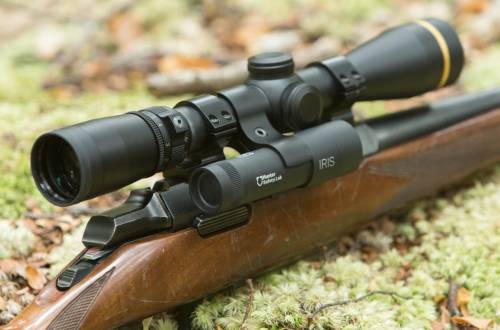Today’s post highlights a selection of the best scopes for beginners and includes an insightful buying guide to help you navigate the waters with ease. If you are throwing yourself into the shooting and hunting world, getting your first rifle scope can be pretty daunting as the market offers numerous options.
Telling apart the brands is taxing making the hunt for a quality starter riflescope overwhelming. Worry no more, your quest for an excellent beginner scope brought you here.
Scopes are complex devices with many moving parts and principles that work together to ensure that the scope works properly. The key to finding the best beginner scope that satisfies your needs is having the necessary information regarding riflescopes.
In today’s post, we shine a light on all matters to do with beginner scopes and include an insightful buyer’s guide to help you find the best companion for your rifle. Fundamentally, the scope should have optimal viewing and precision both of which will increase your chances of a successful shot.
What Magnification Do You Need?
Magnification is one of the key features of a rifle scope. It is the range in which you can multiply the unaided eye’s vision. The longer the distance between the hunter and their target, the more magnification they will need.
However, the higher the magnification the narrower the field of view. If you are looking to hunt very swift animals, it is more advisable to go for a low-powered variable rifle scope that will manage the effects of magnification and the alteration of the field of view.
There is no ideal magnification as the shooting needs vary from one shooter to the other. The best magnification will be dependent on your hunting style, the game you hunt and the distance you intend to shoot a target from. As a beginner, it’s wise to start low and scale up as you sharpen your shooting skills.
5 Best Scopes for Beginners
Having known the functionality of a riflescope, it’s time we look at the best scopes for beginners and what they bring to the table.
1) Burris Fullfield II 3-9×40 mm Rifle Scope
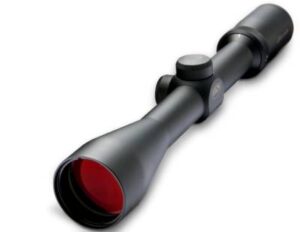
The Fullfield II 3-9×40 riflescope combines classic features with modern hunting needs to deliver practical solutions for various hunting and shooting situations.
As one of the best scopes for beginners, this riflescope sets the standard when it comes to accuracy, reliability and affordability. This iconic riflescope features high-definition glass for utmost clarity and color contrast while in the field.
Compared to other starter riflescopes, Fullfield II has a larger objective lens for optimal light transmission. Consequently, it delivers very bright and sharp views even when the prevailing light conditions are not working in your favor.
Furthermore, the lenses are fully multi-coated increasing the success rate in low-light environments. Glare-reducing elements also help deliver crisp images in the bright daylight.
Versatility, speed and accuracy are other attributes that augment Burris Fullfield II’s name among the best scopes for beginners. The variable power helps support multi-use applications. For smooth magnification changes, the scope features easy-grip knurled knobs on the zoom ring for effortless and flawless switches.
The other positive attribute of this riflescope is its durable construction. The tube is purged with nitrogen gas to lock out moisture to prevent internal fogging.
Besides, the scope’s housing is fully waterproof and shockproof to withstand any shock and vibration produced when a rifle recoils. The scope is backed by a lifetime warranty further instilling confidence that it’s of top quality.
Features
- Fully multi-coated optics for maximum light transmission
- Larger precision-ground lenses for enhanced low light performance
- Positive steel-on-steel adjustments ensure repeatability
- Completely waterproof, fogproof and shockproof
- Variable power to handle several hunting applications
- A knurled metal zoom ring for easy grip and durability
2) Vortex Crossfire II 2-7x32mm Rifle Scope
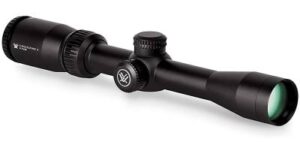
This is a great beginner scope that delivers exceptional performance at an unbeatable price. Speed, unparalleled light gathering ability, accuracy and dependability are the hallmarks of the Crossfire II 2-7×32 riflescope.
As one of the best scopes for beginners, Crossfire II 2-7 x32 is packed with incredible features that deliver a one-of-a-kind performance exceeding the standards of riflescopes in the same price bracket.
At the heart of the excellent optical system, you will find fully multi-coated lenses that enhance light transmission for brighter and crisper images. The tube housing the optics is of exceptional strength for durability.
A tough single-piece design help enhance the alignment to better the accuracy and optimize visual performance. For reliable performance, the tube is filled with nitrogen gas and its O-rings are fully sealed to lock out moisture and other elements that might impede your vision. The scope is also rugged to tolerate vibrations and shocks from rifles.
Anything with Vortex name of it is top-quality regardless of the price. From the quality of the glass to the turrets, this scope will kick off your shooting/hunting career on the right track.
The turrets come with caps for protection and to prevent accidental dialing. The other important addition is the fast focus eyepiece which aids with rapid and fluent focusing of the reticle.
Features
- Fully multi-coated optics for increased light transmission
- Long eye relief for a safe shooting experience
- A fast-focus eyepiece permits effortless focusing of the reticle
- The tough construction of aircraft-grade aluminum
- Fully waterproof, fogproof and shock-resistant
- Capped reset turrets for zeroing after sighting in the scope
- Hard anodized finish to camouflage the shooter’s position
3) Leupold VX-Freedom 2-7x33mm Rifle Scope
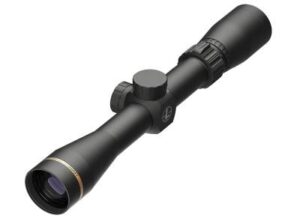
Kick-off your shooting journey with a dependable riflescope with the VX Freedom 2-7×33. This riflescope brings to the table the best-in-class optics housed in a compact unit for an optimal visual experience. As one of the best scopes for beginners, VX-Freedom 2-7×33 is your ideal extra eye for close-range shots and precise intermediate shots.
For the ultimate sighting experience, the scope features a quality optical system that boasts extraordinary light transmission. This delivers the crispest images at any time of the day. For durability, these lenses are protected by a scratch-resistant coating that keeps them clear for life.
This riflescope is of outstanding quality and a great bargain. It suits the needs of every beginner looking for value and performance in one unit. The Twilight light management reduces glare, delivers higher contrast and unrivaled performance in the magic hours when light is dwindling.
What are you waiting for? Add a reliable scope to your gear and start your hunting/shooting career right.
Features
- Hunt-Plex reticle delivers the needed precision for small targets and long shots
- Variable power for handling different shooting scenarios
- Lockable eyepiece for a customized focus setting
- Lenses protected by a scratch-resistant coating
- Fully waterproof, fogproof and shockproof
- Excellent low-light performance
4) Bushnell Banner 3-9x40mm Rifle Scope
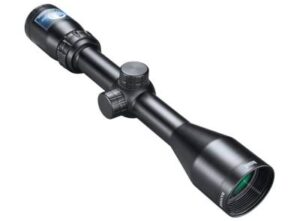
If you are looking for a great starter scope for plinking, look no further than the Bushnell Banner 3-9x40mm scope. This riflescope delivers outstanding performance at an unbeatable price tag.
The scope is designed with user-friendly features that are easy to comprehend. As a beginner, you want a scope that lets you have fun making it a perfect choice for you.
Banner 3-9×40 scope is completely O-ring sealed to keep moisture out to prevent internal fogging. When hunting in a wide range of temperatures, the scope will stay clear giving you a seamless experience.
For relentless performance for long, the scope is filled with argon gas for stability despite the field conditions. Long-term use is further supported by a shock-resistant construction.
Bushnell understands perfecting a shot requires an excellent optical system. The lenses on this riflescope are top-class. They are fully multi-coated to increase light transmission for crisp and high-contrast images.
The other positive attribute of this riflescope is extended eye relief. This gives your eye more distance, especially when mounted on a high-recoiling rifle. Hit the outdoors with confidence and rest assured that this riflescope will get the job done.
Features
- Multi-X crosshair reticle
- Fully multi-coated optics for bright and clear images
- Waterproof, fog proof and shockproof
- A classic magnification range ideal for hunting
- Long eye relief to protect your eyebrow when mounted on a high-recoil rifle
- Effortless adjustments for windage and elevation
5) Leapers UTG 3-12x44mm Compact Rifle Scope
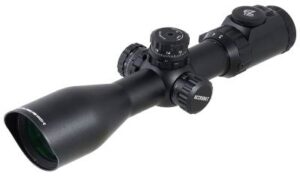
If you are looking for a compact rifle scope, this is an ideal choice for you. It has a 30mm diameter tube that is built on a true strength platform completely sealed and Nitrogen filled for reliability and durability.
The scope is shockproof, rainproof and fog-proof making it a perfect partner for your rifle when hunting/shooting in unfavorable weather conditions. It features the best class emerald lenses that are multicoated allowing maximum light transmission thus yielding bright and clear images.
The innovative EZ-TAP Illumination Enhancing (IE) system has a dual-color mode of Red and green and also a 36-color multi-color mode allowing you to seamlessly hunt during all weather and light conditions.
This riflescope will give a parallax-free aiming experience as it has a parallax Side Wheel Adjustable Turret. In addition, it has elevation and windage turrets that complement one of the most critical parts in the optic for proper zeroing.
Features
- A 30mm diameter tube provides ample space for optimal internal adjustments
- Built on true strength platform for rigidity and durability
- Completely waterproof, shockproof and fogproof
- Best class emerald multicoated lenses allow maximum light transmission.
- Innovative EZ-TAP illumination Enhancing allows you to hunt seamlessly during all conditions.
- A parallax side turret to make you aim parallax free.
- Has elevation and windage for proper zeroing.
Related Posts
Considerations when Choosing the Best Scopes for Beginners
Choosing a Reticle
A reticle is an aiming point also known as the crosshair of your scope. There is the Mil-dot reticle that is often referred to as the ballistic does not have a truly ballistic functionality. This type of reticle consists of evenly spaced dots or half dots while a ballistic reticle is designed around the ballistic curve of a given round.
In a ballistic reticle, the amount of drop increases and loses velocity as any round travels downrange and the corresponding aim point to different yardages must be further apart to make the reticle fully ballistic.
Therefore, due to the even and consistent spaces of the dot distances of the Mil-dot reticle, the ballistic curve of the bullet is not accounted for in long-range shooting.
The Mil-dot is better suited as a range-finding reticle. Calculations are possible as the dot distance is usually known thus you can make the calculations depending on the magnification level.
For a beginner, there are too many calculations that are required on the fly for effective use. If you are looking to get a ballistic reticle, steer away from the Mil-dot.
Focal Planes
Riflescopes with the first focal plane have gained a lot of popularity in the market. This type of scope aligns the reticle and the target lenses in that they are affected equally by magnification changes.
On the other hand, for the second focal plane scopes, the reticle remains the same size despite the magnification of the target. Considering the mil-dot reticle functionality, it is easy to use a scope that the reticle changes as the magnification changes.
On the flip side, for a true ballistic reticle, there is no demand that the scope remains on the designated power as the reticle is designed around making the scope more flexible.
Problems arise where the ballistic reticle is not specific to a caliber because the changing magnifications allow the reticle to be tuned in a way to that specific round. In this case, the flexibility is taken away when using a first focal plane reticle as the target will always be related to the reticle in the same spaces.
If you are keener on flexibility, get a second plane reticle. If you want to take advantage of the ability of the mil-dot to make measurements then the first focal plane would be good. However, first focal planes are more expensive compared to second focal plane riflescopes.
Parallax
Parallax error is not a focus issue but causes a variance in the point of impact as the target and reticle are on different optical planes. Scopes with an adjustable objective lens or side focus system can effectively correct parallax as they adjust internal lenses to remove the error.
However, note that resolving parallax does not mean that you have perfect focus and having perfect focus does not mean you have resolved parallax. You know that parallax has been resolved by having the reticle and the target move unanimously when you tilt your head in all directions.
In most hunting escapades, parallax error is almost negligible. If you do not have to adjust for parallax, get a simple scope without all the complications. Complicated scopes many at times contribute to errors made while hunting.
Tube Diameter
First and foremost, there is always a trade-off between the tube diameter and the weight. The bigger the tube diameter, the more the weight. However, larger diameters give more space for internal components such as knobs that increase the scope’s functionality.
Moreover, the optics are better in larger tubes. Depending on the nature of your escapades get the most appropriate riflescope. If you will be moving a lot, get one with a smaller diameter as you would want to save yourself from carrying around a heavy riflescope. If you do not move a lot, you can get a larger tube and maximize the optics and functionality.
Adjusting your Diopter
Diopter adjustments are only meant to be set for your eye and no further adjustments are required. Failing to adjust the diopter results in a fuzzy reticle which leads to inaccurate aiming.
To adjust the diopter, look through the rifle scope at a plain background that is about 20 feet away, and adjust the diopter until your view is clear. You can also ask the store where you get your scope from to help you adjust the diopter.
Exit Pupil
You get the exit pupil by dividing the diameter of the objective lens by the magnification. In low light conditions always keep the exit pupil above 4mm as it helps to give your dilated eye adequate light. If you are hunting during daylight with perfect light conditions, you will require a smaller exit pupil.
Therefore, if you are purchasing a riflescope, ensure that it provides a 4mm exit pupil throughout the magnification. There is a tradeoff between getting a scope with either less magnification or one with a larger objective lens.
The Size of the Objective Lens
The larger the diameter of the objective lens, the more light the scope transmits resulting in brighter images. However, the larger the objective lens, the heavier the rifle scope. There is a trade-off between weight and transmission. Go for the rifle scope that is most practical for you.
Elevation and Windage Adjustment
Elevation and windage adjustment turrets are used to adjust the position of the bullet’s impact. While elevation adjustments move the bullet’s impact up and down, the windage adjustments move the impact left and right concerning the reticle.
For beginners, the adjustments are not made again once you sight in your rifle. The adjustments come in handy for tactical long-range shooters.
Lens Coatings
Lens coatings assist in light transmission as the coatings reduce the loss of light caused by reflection. The higher the quality of the lenses the brighter and clearer your images will be. Lens coatings come at a higher price though it is a worthy investment.
Read: Best Red Dots for Glock 19
How to Mount a Riflescope
The first step in getting the perfect shot in low-light conditions is ensuring that your rifle scope is well mounted. The best part is you can easily mount a rifle by yourself. Below are the steps of mounting your rifle scope.
- Prepare the Scope and Gun
This is done by first greasing the bases, screws and holes with Outers Crud Cutter or lighter fluid. Wipe metal dry. On the top of the receiver, oil lightly as this is where the base will sit. On every screw, put a droplet of medium-strength Loc-Tite and with a screwdriver, tighten the base screws as tight as you can.
- Install the scope rings
All the scopes come with the manufacturer’s instructions on how to install the scope rings. To twist the ring, use a one-inch wooden dowel or pipe as using the scope as a lever might result in having the ring twisted.
- Set the scope on the rings
On the bottom parts of the rings, lay the scope and then attach the top parts of the rings. Adjust the scope accordingly before tightening the rings. Do not set the scope too close to your eye as you might get hurt during recoil. Most scopes have an eye relief of 3-4 inches thus you should set it 3-4 inches away from your eye when leaning into the rifle.
- Adjust the scope
Adjust the scope to perfection by adjusting the cant to ensure the crosshairs of the scope are perfectly vertical. Then do a check to make sure that the rifle is not leaning towards any side and turn the scope to line up the crosshairs with the vertical line.
- Secure the scope
Once everything is in place and all lined up tighten the screws to secure the scope. You do not have to crank them up too much like the screws that hold the base to the receiver but ensure that they are tight enough to hold the scope in place.
Best Scopes for Beginners FAQs
Why Should I Get a Rifle Scope?
The main reason why a hunter would go for a scope is because of simplicity in that it eliminates about one-third of the complexity of lining up iron sights during aiming.
When using a scope, all you need to do is align the reticle with your target thus making shooting for beginners much easier. In addition, most rifle scopes will magnify your target making it seem closer thus enabling you to make more accurate shots.
What are the types of Lens Coatings?
Most of the rifle scopes have lens coatings. The coatings give better light transmission resulting in brighter and sharper images as the coating helps reduce loss of light. In addition, the coatings help the rifle scope to be water and fog-proof. Below are the types of lens coatings you can get and their description.
- Coated lenses – They have a single layer on at least one lens surface.
- Fully Coated lenses – They have a single layer on all air to glass surfaces.
- Multicoated lenses – They have multiple layers on at least one lens surface.
- Fully Multicoated lenses – They have multiple layers on all air to glass surfaces.
Conclusion
For a beginner, you should aim for an easy-to-use rifle scope that will make your learning experience much easier. The above suggestions would help you make a better choice when picking the best rifle scope. Always choose one that will meet your hunting needs, allow you to make accurate shots and suits your preference.

